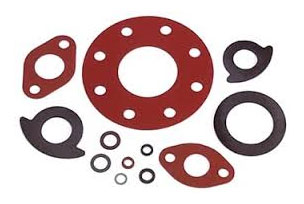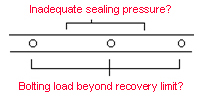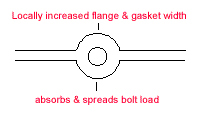An improperly designed, casually installed, or poorly manufactured gasket can lead to plant shutdowns, financial losses, plant capacity reductions, environmental damages and safety hazards that are sometimes fatal. Therefore there is an increased awareness from customers to enhance sealing performance. Additionally, there is also a need to understand the advantages and limitations of newer products such as asbestos substitutes and other innovative designs.
Parikh Gaskets has almost 3 decades of experience in manufacturing gaskets and seals. In addition we have strong on-going relationships with our base material suppliers. Collectively we can assist you select the best solution for your sealing requirements.
In this area we have provided some useful information that will help you design and install seals and gaskets as well as providing you easy access to material specifications.
A gasket is a compressible material, or a combination of materials, which when clamped between two stationary members prevents the passage of the media across those members. The gasket material selected must be capable of sealing mating surfaces, resistant to the medium being sealed, and able to withstand the application temperatures and pressures.

Gaskets are commonly made of a flexible material such as rubber, paper, or cork. In fact, there are many different materials that gaskets can be made out of and so gaskets cannot simply be defined by means of the material that they are made out of. Gasket materials are, however, typically flexible, as they are usually compressed between two other surfaces. Having said this, it is also possible to find gaskets made of metal: such as spiral wound or camprofile gaskets.
A similar problem arises when we try and define a gasket by its function. Gaskets can be used for many different purposes, such as: sound and noise reduction, anti-vibration, packaging, hygiene, sealing, and as supports and mountings. For these reasons gaskets are found in many different products and in many different industries. For instance, gaskets can be found inside of: cars, planes, boats, trains, pumps, electrical equipment (from electronic tills and hi-fi equipment to lighting, to industrial electrical transformers). Gaskets find application in industries as diverse as food processing, petrochemical, pharmaceutical, aerospace, automobiles, water and oil and gas.
The properties of a gasket are typically those of the material out of which it is manufactured. For this reason gasket materials are selected for their characteristics: such as their resistance to chemicals, acids, alkaline, extreme temperatures, pressures, and their ability to withstand different environments (such as deep-sea, mining, and even in space). Similarly, the specification of a gasket is defined by its operating environment.

Perhaps the most common use of a gasket is as a component of a sealing system, in which one of the major functions of the gasket is to create a seal between two other surfaces. For instance, pipe gaskets are used to create a seal between two pieces of pipe when laying a pipeline. The exact function of a gasket in this respect is to prevent the escape or ingress of fluids (liquids or gases) even at extreme pressure and temperature. Yet the function of a gasket is not only to provide a seal to prevent liquids or gases escaping, but it is also an important safety device. In this respect it is important for the gasket to be the weakest component of the sealing system, so that it fails in response to a problem. The consequences of a gasket not failing in response to a problem are far greater than simple gasket failure. If the gasket does not fail in response to a build in pressure then the consequence is potential bursting of the pipe and/ or explosion.
It is also important that the gasket allows for essential maintenance, by allowing the sealing surfaces to be separated and reassembled. For this reason it is important for the gasket to remains in a good a condition for as long as possible. The life of a gasket can be significantly improved by selecting the right material for the application, and by taking into account all of the features of the environment in which it will be used.
As we have seen, it's not easy to define what a gasket is: as they can be made out of many different materials, perform many different functions, and be used in many different industries. Having said this, the most common use of a gasket is to interface between two surfaces to improve the function of the components.
If you have any technical questions then please contact us.
Gasket function can be divided into two stages
Factors influencing Gasket Function
Many factors can influence gasket function. External factors such as bolts and flanges should also be considered in conjunction with gaskets as they influence sealing performance.
Application parameters need to be first considered before selecting a gasket. These include
The following parameters should be considered for gasket material selection
The above need to be complimented by proper plant maintenance practices. These include the following
Flange Condition

Bolting
Bolt stress during assembly: In order to maintain a seal, it is extremely important that proper bolt stress is maintained during assembly. Proper bolting equipments should be considered to maintain these stresses.
Bolting Procedure: In order to maintain uniform bolt stress, it is recommended to follow the below sequence. Bolting should also be done in four stages with 33% torque during the first stage, 66% torque during the second stage, 100% torque during the third stage, and a 100% retorque during the fourth stage.
Bolt Lubrication: Good lubrication is necessary to maintain uniform torque. In the absence of proper lubrication, torque will be lost to friction.
Guide to basic Gasket Design
Basic information concern gasket design can be found in this section. The information here is offered as a general guide only, please check the details of your application and material specifications carefully.
The gasket is only one component of a sealing system. The other components are the mating surfaces, the clamping method, the internal and external environments. First we need to consider the general function of a gasket:
Prime Function
Major Requirement
Gasket Design Guide
Step 1 : Material Selection
Step 2: The Flange and the Gasket

Once the material is chosen the flange and bolting need to be designed to ensure the following: The gasket is compressed evenly over the whole surface area. Thin flanges or excessive distance between bolt holes can result in some portions of the gasket being crushed whilst other areas are not sufficiently loaded to prevent leakage or blow-out.

The flange and gasket will appear thus
Vary the width of narrow flanges. If the bolts are widely spaced and the flange width is constant then excessive loading will occur on the limited material around the bolts.

For Example : This Design Will Even The Loading
Note: Sheet metal flanges can be stiffened by forming a lip. Soft materials can be protected by using compression stop (could be a washer).
Additional Requirements for Dynamic Sealing
Gaskets can be classified into three categories: soft cut, semi-metallic and metallic types. The physical properties and performance of a gasket will vary extensively, depending on the type of gasket selected and the materials from which it is manufactured. Physical properties are important factors when considering gasket design and the primary selection of a gasket type is based on the following :
1) Soft Cut Gasket
Sheet materials is used in low to medium pressure services. With careful selection these gaskets are not only suitable for general service but also for extreme chemical services and temperatures.
2) Semi - Metallic Gasket
These semi - metallic gaskets consist of both metallic and non-metallic materials. The metal provides the strength and the resilience of the gasket and the non-metallic component provides the conformable sealing material. These gaskets are suitable for low and high pressure and temperature applications. A wide range of materials are available.
2.1) Spiral Wound Gasket
| FILLERS MATERIALS | MAX. WORKING TEMPERATURE |
|---|---|
| Graphite | 600°C |
| Graphite 99.8% purity | 1200°C |
| Non asbestos | 550°C |
| PTFE | 250°C |
Commonly Used Winding Material
| Winding Material | Maximum Temperature | ASME B16.20 / Colour Coding |
|---|---|---|
| Carbon Steel | 500°C | Silver |
| 304 Stainless Steel | 650°C | Yellow |
| 316L Stainless Steel | 800°C | Green |
| Duplex UN S31803 | 800°C | N/A |
| 347 Stainless Steel | 800°C | Blue |
| 321 Stainless Steel | 800°C | Turquoise |
| Monel 400 | 450°C | Orange |
| Nickel 200 | 315°C | Red |
| Titanium Gr 2 | 350°C | Purple |
| Hastelloy B-2/B-3 | 450°C | Brown |
| Hastelloy C-276 | 450°C | Beige |
| Inconel 600 | 1000°C | Gold |
| Inconel 625 | 450°C | Gold |
| Inconel X-750 | 1000°C | N/A |
| Incoloy 825 | 450°C | N/A |
| Zirconium | 500°C | N/A |
| Super Duplex | 600°C | N/A |
| 254 SMO | 600°C | N/A |
| Titanium Gr7 | 350°C | N/A |
| Hastelloy C-22 | 450°C | N/A |
| Hastelloy G-31 | 450°C | N/A |
| Alloy 20 | 600°C | N/A |
Thickness of Spiral Wound Gasket
| Initial thickness | After Compression |
|---|---|
| 2.5mm | 2.0 mm |
| 3.2mm | 2.5 mm |
| 4.5mm | 3.0 -3.2 mm |
| 6.4mm | 4.6 - 4.8 mm |
| 7.2mm | 4.8 - 5.00 mm |
Note : Maximum temperature ratings are based upon hot air constant temperatures. The presence of contaminating fluids and cyclic conditions may drastically affect the maximum temperature range.
2.2) Camprofile Gaskets
Sealing Layer Materials And Sealing Stresses
The following table gives information regarding different types of materials offered as sealing layer materials by Parikh Gaskets. Also given is recommended seating stress range for reliable and effective performance:
| Material | Temp (Deg.C) |
Max. Operating Pressure (Bar) |
Gas Tightness | Application | Seating Stress | |||
|---|---|---|---|---|---|---|---|---|
| Min | Max | Min (N/mm2) | Optimum (N/mm2) | Max (N/mm2) | ||||
| Graphite | -200 | 600 | 250 | Good | Aggressive Media |
20 | 90 | 400 |
| PTFE | -200 | 250 | 100 | Good | Aggressive Media |
20 | 90 | 400 |
Core Thickness
When a Camprofile is replacing an existing gasket (eg. spiral wound gasket); Parikh Gaskets recommends a 4mm thick core to prevent unnecessary stresses on existing pipe lines. For new system, we recommend 5 mm thick cores. The value should be taken into account at the design stage.
| Pipe system | Core thickness | Seated Thickness (Core + 2 sealing layers) |
|---|---|---|
| Existing | 4mm | 5.0mm to 5.2mm |
| New | 5mm | 6.0mm to 6.2mm |
General
Parikh Gaskets recommends the following best practices to ensure correct gasket fitting.
Recommendations
Use of Graphic & other Anti-Stick coatings
A list of Questions That we Frequently Encounter From Customers :
What is the right material for my application?
The right material for your application will be determined by what you are going to use it for. The easiest way to decide which material is right for your application is to use our Gasket Material Selector and Prosperities of Gasket Materials charts. If in doubt, please contact us for advice
What thickness material should I specify?
As a general rule you should choose the thinnest material possible for your application, as the pressure exerted on the gasket will increase with its thickness. The thickness of the material will be dictated by the state of the flanges in question, and the compression required to seal.
How do I work out the Outer Diameter (O.D.) and Inner Diameter (I.D.) of my gasket?
The inner dimension of your gasket is the size of the hole or bore. To calculate the outer dimension of your gasket, measure the outer dimension of the gasket (the full diameter of the gasket).
How do I determine which Class or Table of gasket I need?
The easiest way to work out which class or table of gasket you need is to consult our Gasket Dimensions Guide.
How do I work out the Pitch Circle Diameter (P.C.D.) of my gasket?
The pitch circle diameter is the diameter that specifies the centre of bolt holes of your gasket. The P.C.D. is measured from the centre of the bore.
Below can be found a glossary of basic gasket terms. For further technical advice, please do not hesitate to contact us.